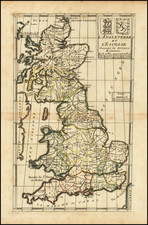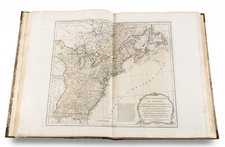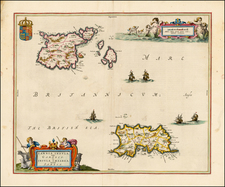With Rare Text Panels
Detailed map of the Western part of the Roman Empire, extending from Greece to the Atlantic, with the British Isles in the north.
Translated from Latin, the title suggests: "Historical Theatre in the four hundredth year of Christ in which both the state of the Roman Empire and the Barbarians residing around are presented to the eye, the Western part . . .". This map provides a vivid window into the world of the 5th century, through the lens of the early 18th century.
This large-scale, meticulously detailed map illustrates the western part of the Roman Empire around 400 A.D., a period steeped in historical significance as the empire was in its declining phase, plagued by invasions from various 'barbarian' tribes.
The map shows a vast expanse from Britain in the north to the northern fringes of Africa in the south, and from the Iberian Peninsula in the west to the Black Sea in the east. It is intricately detailed, with territories divided among the Romans and various Germanic, Celtic, and other tribes, reflecting the turmoil and dynamic changes of this period. De L'Isle's attention to detail is evident in his meticulous representation of the various tribes such as the Visigoths, Ostrogoths, Vandals, and Franks, highlighting the extent of their influence and territories at the time.
In conclusion, Guillaume De L'Isle's "Theatrum Historicum ad annum Christi quadringentesimu in quo tu Imperii Romani tu Barbarorum cirucumincolentiu status oculos ponitur Pars Occidentalis . . . 1705" is not just a cartographic representation of the Western Roman Empire in the fifth
The map includes the following notes in Latin:
America as possibly being the lost civilization of Atlantis
Americam Gerardus Mercator, Abrahamus Ortelius et ali Atlanticam Platonis Insulam esfe arbitrati sunt: arbitratus est et Guillelmus Sanson Geographus Regius, qui et ejus Mapp am non inclegantem publicavit, in qua Insulam decem Neptuni filiis ex Platone distributam exhibuit et unicuique filio fortem as suam as signavit.
Translation: "Gerard Mercator, Abraham Ortelius, and others have considered America to be Plato's Atlantic Island (Atlantis). William Sanson, the Royal Geographer, also held this view, and he published a not ungraceful map on which he exhibited the Island divided among Neptune's ten sons, according to Plato, and he assigned a specific lot to each son."
This passage reflects the speculation of some of these early cartographers that the newly discovered Americas could be the location of the lost island of Atlantis as described by Plato.
Phoenician Sea Travel and Discoveries in the Atlantic Ocean
Phænices qui Gadiram inhabitant dum extra Columnas Herculis navigarent, ad Regiones quasdam applicuere ulva algaqiplenas quæ aftibus maris rigabantur. Arist in admirand. Oceani intransmeabilis ulteriores fines cuiquam transfretare, quia resistente ulvâ non licuit et ventorum spiramine quiescente impermeabiles esse sentiuntur. Jor. de Reb. Get
Translation: The Phoenicians, who inhabit Gadir, while sailing beyond the Pillars of Hercules, came upon certain regions full of seaweed and algae that were washed by the waves of the sea. Going into the admirable Ocean, they found it impassable, unable to cross its furthest limits, as the resisting seaweed did not permit, and with the calming of the wind, they felt it to be impassable. Jor. de Reb. Get
This text seems to be discussing the Phoenicians and their seafaring activities beyond the Pillars of Hercules (a term that the ancient Greeks used for the promontories that flank the entrance to the Strait of Gibraltar), with an emphasis on certain geographical and oceanic phenomena.
The Fortunate Islands
Fortunatas Insulas (quæ ad quinque gradus longitudinis ad minimum extenduntur) Ptolemaeus ponitsub eodem Meridiano
Translation: "Ptolemy places the Fortunate Islands (which extend at least to five degrees of longitude) under the same meridian."
This passage indicates that Ptolemy, the ancient geographer and astronomer, depicted the Fortunate Islands (Canary Islands) on his geographical charts or writings to be under the same meridian and extending to at least five degrees of longitude.
Roman Consul Suetonius Paulinus, a Roman consul crosses the Atlantic Ocean
Suetonius Paulinus quem Consulem vidimus, primus Romanorum Ducum transgresfus Atlantem aliquot millium spatio, prodidit de excelsitate quidem ejus quæ cæteri etc......Decumis se eo castris pervenisse et ultra ad Aluvium qui Niger vocatur per Solitudines nigri pulveris eminentibus interdum velut excustis cautibus loca inhabitabilia servore, quanquam hyberno tempore experto Plin. lib.V.C.I.
Translation: "Suetonius Paulinus, whom we have seen as Consul, was the first among the Roman leaders to cross the Atlantic by some thousands of miles. He reported on its exalted nature which others etc... He claimed to have arrived there by the tenth camp and beyond to the alluvial (floodplain or riverbed) region called Niger through desolate areas of black dust, with cliffs occasionally seeming to have been thrown up, places uninhabitable due to heat, although experienced during winter time. Plin. book V. C. I."
The reference "Plin. book V. C. I." is most likely to Pliny the Elder's "Natural History", Book V, chapter I. However, without the complete context, it is challenging to provide an absolutely precise translation, and some parts of the text ("quæ cæteri etc.") are not clear.
Roman Conqust of Fezzan under Cornelius Balbus
Ad Solitudines Africa supra Minorem Syrtin dictas, versa. Phazania est (hodie Regnum Fezan) ubi gentem Phazaniorum urbesque Alelen et Cillabam subegimus Omnia armis. Romanorum superata, et a Cornelio Balbo triumphata. Plin.l.v.c.5.
Translation: "Towards the deserts of Africa, named above the Lesser Syrtis, is Phazania (now the Kingdom of Fezzan), where we have overcome the tribe of the Phazanians and the cities Alelen and Cillabam. All [of these] have been overcome by Roman arms, and triumphed over by Cornelius Balbus. Plin. Book 5, Chapter 5."
This passage suggests that the Roman forces, under the command of Cornelius Balbus, conquered the region of Phazania (known as Fezzan today), including the tribe of the Phazanians and the cities of Alelen and Cillabam. The reference "Plin. Book 5, Chapter 5" likely refers to Pliny the Elder's "Natural History".
Rarity
This is the first time we've seen the map with text panels.
Guillaume De L'Isle (1675-1726) is probably the greatest figure in French cartography. Having learned geography from his father Claude, by the age of eight or nine he could draw maps to demonstrate ancient history. He studied mathematics and astronomy under Cassini, from whom he received a superb grounding in scientific cartography—the hallmark of his work. His first atlas was published in ca. 1700. In 1702 he was elected a member of the Academie Royale des Sciences and in 1718 he became Premier Geographe du Roi.
De L'Isle's work was important as marking a transition from the maps of the Dutch school, which were highly decorative and artistically-orientated, to a more scientific approach. He reduced the importance given to the decorative elements in maps, and emphasized the scientific base on which they were constructed. His maps of the newly explored parts of the world reflect the most up-to-date information available and did not contain fanciful detail in the absence of solid information. It can be fairly said that he was truly the father of the modern school of cartography at the commercial level.
De L’Isle also played a prominent part in the recalculation of latitude and longitude, based on the most recent celestial observations. His major contribution was in collating and incorporating this latitudinal and longitudinal information in his maps, setting a new standard of accuracy, quickly followed by many of his contemporaries. Guillaume De L’Isle’s work was widely copied by other mapmakers of the period, including Chatelain, Covens & Mortier, and Albrizzi.












![A New Map Shewing all the several Counties, Cities, Towns, and other Places mentioned in the New Testament . . . [shows Cyprus]](https://storage.googleapis.com/raremaps/img/small/90593.jpg)

![Le Vere Imagini et Descritioni delle Piu Nobilli Citta del Mondo [The true images and descriptions of the most noble cities in the world]](https://storage.googleapis.com/raremaps/img/small/92842.jpg)

